Is China's economy headed for a crash in 2014? It's an extreme question that would be laughed at by many. After all, most believe that China is the world's new powerhouse, off the back of near 10% annual growth over the past decade. And the vast majority of economists and policymakers are sanguine about the country's economic prospects, pointing to still healthy data and confidence in recently-announced structural reforms to steer China in the right direction.
But as Asia Confidential outlined in a recent post, the bulls' arguments are looking much weaker post two spasms of credit stress. And there are four crucial things that these arguments seem to ignore:
- The investment-driven, debt-laden economic model of China simply isn't sustainable
- Extraordinary credit growth is yielding less and less benefit as investment returns deteriorate
- The recent spikes in inter-bank rates and high-profile debt defaults (China Everbright Bank International, (0257) and bankruptcies (coal mining group, Liansheng Resources Group) point to severe stresses within the financial system
- The structural reforms are a long-term positive, but short-term net-negative for the economy.
For the record, we're not predicting a China crash this year. We'll leave sure-fire predictions (which are often wrong) to others. What we are suggesting though is the odds appear to favour a more serious economic downturn in China over the next few years. And that those odds have increased given recent events.
Today we're going to look at the bulls' views in depth and what's wrong with them. We'll also delve into the countries and sectors which seem most vulnerable to a China downturn. While the Chinese stock market has been a dog for years and told a large tale about the country, many of those most reliant - either directly or indirectly - on China investment demand still seem to be priced for better times ahead.
The bull case
First, let's take a look at the bull case for China's economic prospects. In simple terms, it goes something like this:
1) GDP growth accelerated in the third quarter to 7.8%, up from 7.5% in the prior quarter. According to the bulls, this shows that the economy is recovering, or stabilising at worst, thanks to various stimulus measures and government interventions into the inter-bank market.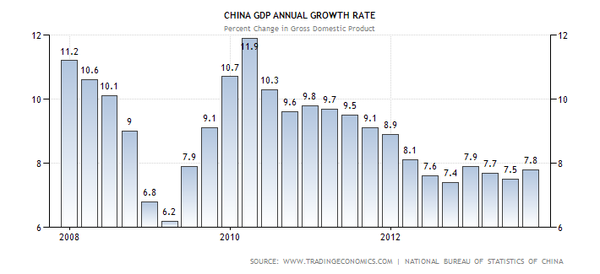
2) Chinese exports beat forecasts in November, up almost 13%. This indicates that the world's second-largest economy is benefiting from a recovery in developed markets. That's important given China's reliance on exports. 
3) Despite all of the concerns about potential bad debts from the massive 2009 stimulus, non-performing loan (NPL) ratios remain low.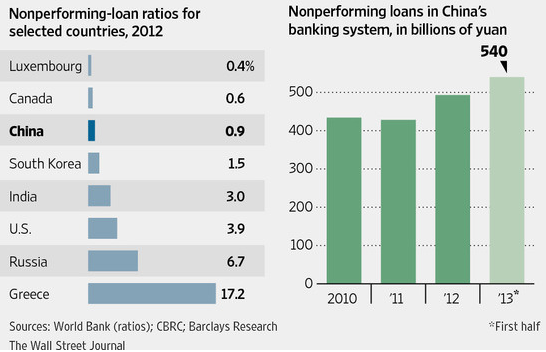
4) The new Chinese leadership announced a bold reform agenda late last year, which should help re-balance the economy away from investments towards consumption. Those positive on China suggest this should be a smooth re-balancing and ensure strong economic growth for years to come.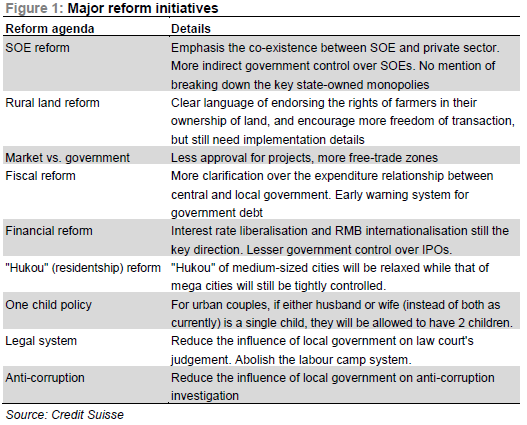
5) Most, including this author, think Xi Jinping may be the man to make the tough decisions to propel China's long-term growth after the previous regime neglected much-needed reform. Clearly, he's been focused on consolidating his own power; economic reforms should come next.
6) If the economy does suffer a major downturn, China has ample resources to fight such an occurrence, in the form of almost US$3.7 trillion in foreign exchange reserves. This should ensure China doesn't have the so-called hard economic landing which critics predict.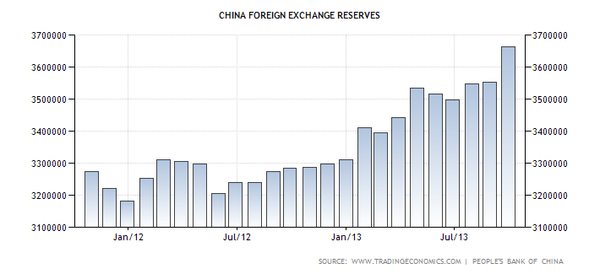
What's wrong with it
The weaknesses in the bull case are the following:
- Almost everyone agrees the that export-led economic model used by China over the past 30 years is unsustainable going forward.
- Previous transitions from export-led models in Japan and South Korea have led to sharply lower economic growth.
- Faith in government to engineer a smooth economic transition is also contrary to much historical experience.
Let's run through these one-by-one.
It's important to understand how China's economy got to be so big in a short space of time. The speed of economic ascent has no parallel in modern times and it's been the result of a classic export-led growth model.
What this means is that China has been able to mass produce goods on an unprecedented scale given the appetite for these goods abroad. This has helped lift industrial investment well beyond the level which would be needed if it focused solely on the domestic market. And it's been aided by a key competitive advantage on the global stage: cheap labor. The end result has been that China has been able to suppress domestic demand and pour resources into investment.
The reason why this export-led model is unsustainable is that China now produces so many goods that the rest of the world cannot possibly absorb them all. China's gotten to big for its own good, in crude terms.
When the 2008 financial crisis hit, Chinese exports plummeted and the limits of the model became apparent. However, China cushioned the blow by implementing massive stimulus measures. In effect, it sunk even more money into investments, such as infrastructure, property and factories. The problem to this day is there hasn't been the end-demand for these investments. In other words, export demand has remained soft and domestic demand for goods hasn't been able to pick up the slack.
And a bigger problem is that the much of the investments via the stimulus were debt-financed, principally to state-owned firms. These firms were deemed less risky by banks.
That's created an issue for small firms which haven't had access to bank financing. Given reduced export and domestic demand, they've had to resort to financing from outside the banks, the so-called shadow banking system. They've had to pay much higher interest rates as a consequence. And it's widely known that the collateral used for non-bank financing is less-than-solid, on average.
As you may be able to see from the above, the export-led model which China has used over the past 30 years is running into a dead-end. What the new leadership is now trying to do is transition the economy towards more domestic consumption, so that it can perhaps make up for the drop-off in export growth.
The history of transitions from export-led models doesn't make for pretty reading. These transitions, for Japan in 1973 and South Korea in 1991, led to sharp slowdowns in economic growth, as seen in the chart below.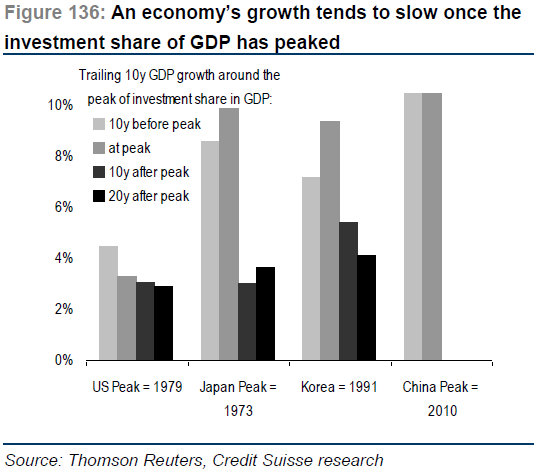
Lastly, faith in the new leadership to deliver a successful transition appears misplaced. As noted above, we think Xi Jinping is the right leader to steer the country for the next decade. And many of his proposed reforms have merit and should help in re-balancing the economy.
However, the fact is that China has hemmed itself into a corner where there are limited solutions in the near-term. Cut back on credit-driven investment and GDP falls sharply. Keep the party going and risk a larger blow-up in the not-too-distant future. Moreover, the bulls conveniently downplay that implementation of structural reforms would be a net-negative for growth in the short run.
As for the argument that China can always use its foreign exchange (forex) reserves to provide further stimulus to prop up the economy, the people who purport this have little knowledge of basic economics.
If China were to use substantial forex reserves in this way, it would become a large net-seller of U.S. Treasury bonds. To prevent a spike in interest rates, the U.S. central bank would have to significantly step up purchases, funded ultimately by private citizens savings. Less of these savings would dampen U.S. consumption and ultimately, Chinese exports to the US. In other words, a move by China to substantially cut forex reserves would not only be a disaster for the developed world but for China itself.
Are recent events a tipping point?
If you agree that China's current economic model is unsustainable and that any transition away from it will be difficult, the question then becomes, 'when might a more serious downturn occur'. The short answer is that no one really knows. But recent events are beginning to show severe stresses in the economy. Perhaps a sign of things to come.
First, it's clear that China is trying to keep the investment boom going to aid GDP growth. Though overall credit growth has slowed somewhat, it's still likely to be up 20% in 2013. That's much higher than nominal GDP.
The continuing credit binge is why property prices in China have remained strong, even though many have seen a bubble in this space for several years.
The problem is that the credit boom is resulting in less bang for the proverbial buck (or yuan in this case). Recent manufacturing surveys have shown a slowdown.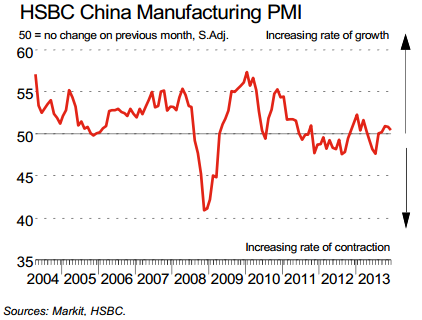
The consumer price index and producer price index have also slowed. The latter indicates excess industrial capacity ie. too many produced goods chasing too little demand.
In addition, there are warning signs of serious stresses in the banking system. Two episodes of spiking inter-bank rates (where banks lend to each other) over the past six months suggest a very fragile credit system. With both, the central bank had to inject money to keep credit flowing, otherwise it would have risked skyrocketing inter-bank rates, resulting in a wave of defaults across the country. There is only so long bad debts from bad investments can be rolled over and covered up though.
Also, there has been widespread corporate credit distress. Coal miner Liansheng Resources Group, has made recent headlines, ending up in court for owing almost US$5 billion. China Everbright Bank has also belatedly admitted to a US$1 billion default on a loan back in June (coinciding with the first spike in inter-bank rates). There are many other rumours of Chinese corporates in trouble. This is hardly surprising with debt/income among corporates at 5x and total corporate debt to GDP being 125%.
In sum, you have still abundant credit-driven investment, but slowing economic output, softening inflation, inter-bank system ructions and corporate debt troubles. Hardly signs of a healthy economy.
Best ways to bet against China
If you agree that China's economy is in serious trouble, the next question is which markets, sectors or companies are most vulnerable? The fall-out from a China downturn would be enormous and widespread, but here is a list of things which appear most susceptible were this to happen (our favourite shorts in order of preference):
1) Australian banks. Mining contributed 50% of Australian GDP growth in 2012 and that's set to slow sharply. A China downturn would send that contribution into negative figures and that's a big deal when mining contributes about 9% to GDP. The Aussie banks are exposed to this slowdown, are among the most expensive banks in the developed world and have huge exposure to a mammoth property bubble which has ironically been driven by Chinese buyers of late. Commonwealth Bank Of Australia., (CBA) is the most expensive bank in Australia and probably the most short-able.
2) China property developers. Given the risks to the bursting of the investment bubble, the good times for property developers are unlikely to last. State-owned China Resources Land (HK: 1109) appears one of the most at risk.
3) The Chinese yuan (vs USD). This will surprise many people given the yuan strength in 2013. However, the yuan is overvalued in my view and highly vulnerable to a downturn in the economy. Moreover, there's the added issue of yen depreciation which has to provoke a reaction from other prominent exporters, such as China, at some point.
4) Fortescue Metals. This Australian iron-ore miner is near 52-week highs as the price of iron ore has recovered nicely. But iron ore and steel are highly vulnerable to a China downturn in investment. Fortescue Metals Group Ltd, (FMG) isn't cheap, has high leverage and is therefore probably the best short in the iron ore space.
5) The Aussie dollar. Yes, the AUD has pulled back a long way already. This could well be a market signal of trouble in China, by the way. But whichever metric you use, the Aussie remains overvalued and would end up much lower should a China downturn eventuate. The Australian central bank talking down the currency is an additional negative factor.
You'll probably notice that the list doesn't include large parts of the Chinese stock market. Keep in mind though that this market (Shanghai Composite) is already down more than 60% from their 2007 peak. This market has signaled trouble in China ever since 2008, but too few have paid attention. Put simply, much is now priced into Chinese stocks. There may be a strong case for the potential inclusion of some of China's second tier banks though as they're the most vulnerable in the financial sector to a downturn.
AC Speed Read
- There are many signs that China's economy is in serious trouble.
- The signs include still booming credit growth but lower growth, softening inflation, spiking inter-bank rates indicating stresses in the financial system, as well as large corporate defaults and bankruptcies.
- These things combined have increased the odds of a more severe China economic downturn this year.
- The best ways to bet on a China crash include shorting the following: Australian banks, China property stocks, the Chinese yuan and iron ore miners such as Fortescue Metals.